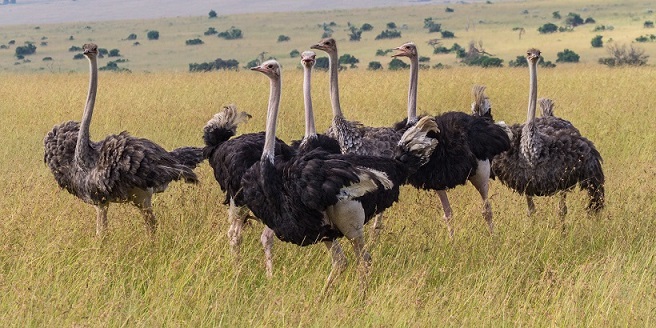The Ostrich: The World’s Largest Flightless Bird
When you think of giants in the bird kingdom one name stands tall: the ostrich. Known as the largest living bird on Earth, ostriches are fascinating creatures that continue to amaze on safari. These giants of the savanna can grow up to 9 feet tall, weigh over 140 kilograms and run faster than most predators.
Why the Ostrich is Truly Remarkable
- The Biggest Bird Alive
Ostriches can grow up to 9 feet tall and weigh as much as 145 kg. Unlike most birds they only have two toes on each foot which helps them run efficiently. - Masters of Speed
They can sprint up to 70 km/h making them the fastest two-legged animal in the world. This speed is their greatest defence against predators like lions and cheetahs. - Survival Experts
Their eyes are about 5 cm wide, the largest of any living land vertebrate, giving them sharp vision to spot threats. Their brains are relatively small for their body size but their instincts and awareness keep them alive. - Savanna Icons
Males have striking black and white plumage while females are gray brown which camouflages them in the wild.
Where to See Ostriches in Kenya
Kenya offers some of the best ostrich viewing experiences in Africa. Each location gives you something special:
- Masai Mara National Reserve
Apart from the famous Great Migration you’ll find ostriches roaming freely. Their presence adds to the diversity of the Mara ecosystem. - Samburu National Reserve
Home to the Somali ostrich with its bright blue neck and legs, a subspecies found mainly in the Horn of Africa region. A must-see for bird enthusiasts. - Tsavo National Park
Kenya’s largest national park known for its “red elephants” also hosts ostriches striding through vast semi-arid plains. A perfect place to see them in wide open space. - Amboseli National Park
Imagine ostriches walking across the plains with Mount Kilimanjaro towering in the background. This is one of the most iconic safari scenes you can capture.
The Cultural Significance of Ostriches
Beyond their physical wonders ostriches hold an important place in African culture and traditions:
- Symbol of Strength and Speed: In many African communities the ostrich represents endurance and swiftness.
- Ostrich Feathers in Rituals: The Maasai and Samburu people have traditionally used ostrich feathers in ceremonial attire as a sign of beauty and power.
- Craft and Art: Ostrich eggs are carved and decorated into ornaments or containers making them both practical and symbolic treasures.
Best Time to Visit Kenya to See Ostriches
Ostriches can be seen all year round in Kenya but your chances of enjoying the best sightings are higher during the dry seasons when wildlife gathers in open plains and around water sources:
- January to March – Hot and dry with thinner vegetation making ostriches easier to spot near rivers and open grasslands.
- June to October – The long dry season is one of the best safari windows. Landscapes are open and you may also catch the Great Migration in the Masai Mara.
- November to December – The short rains create lush green scenery offering great photography opportunities with ostriches striding across vibrant plains.
Unlike migratory birds ostriches don’t travel long distances seasonally so you are almost guaranteed to see them at any time of year.
Why Ostriches Make Your Safari Special
- Their speed size and quirky mannerisms make them fascinating.
- They play an important role in the ecosystem by spreading seeds and grazing to help maintain healthy grasslands.




Comments are closed